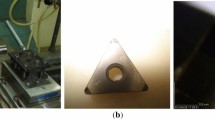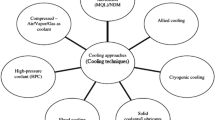Abstract
In metal forming processes tribology plays a significant role for process feasibility and tool lifetime. Boundary and mixed lubrication conditions are predominant in metal forming processes. Hence the appearing real contact area which is mainly influenced by the topography of tool and workpiece has a major impact on friction conditions. For an improved understanding of friction at the interface between tool and workpiece, the flattening behavior of idealized asperities under boundary lubrication conditions is investigated by applying a translucent tool. Various liquid lubricants have been used. It has been revealed that the usage of certain lubricants leads to higher resistance of the asperity against flattening which would be in favor of reduced friction. Topography analysis and finite element simulations have been performed in order to get more insight into the mechanisms leading to this effect. The findings have been transferred to real topographies by micro upsetting tests with ground surfaces.









Similar content being viewed by others
References
Kudo H, Azushima A (1984) Interaction of surface microstructure and lubricant in metal forming tribology. In: Kudo H (ed) Advanced technology of plasticity, I. The Japan Society for Technology of Plasticity and The Japan Society of Precision Engineering, Tokyo, Japan, pp 373–384
Azushima A (2006) In situ 3D measurement of lubrication behavior at interface between tool and workpiece by direct fluorescence observation technique. Wear 260:243–248
Childs THC (1973) The persistance of asperities in indentation experiments. Wear 25:3–16
Chivers TC, Mitchell LA, Rowe MD (1974) The variation of real contact area between surfaces with contact pressure and material hardness. Wear 28:171–185
Wanheim T, Bay N, Petersen AS (1974) A theoretically determined model for friction in metal working processes. Wear 28:251–258
Azushima A (2004) In situ 3D measurement of lubrication behavior at interface between tool and workpiece by direct fluorescence observation technique. In: Proc. 2nd ICTMP, pp 377–384
Azushima A, Kuba S (2005) Direct observation of asperity deformation of specimen with a smooth surface in indentation process. In: Bariani P (ed) Proc. of 8th ICTP, pp 597–598
Azushima A (2005) In lubro 3D measurement of oil film thickness at the interface between tool and workpiece in sheet drawing using a fluorescence microscope. Tribol Int 38:105–112
Geiger M, Engel U, Vollertsen F (1992) In situ ultrasonic measurement of the real contact area on bulk metal forming. Annal CIRP 41:255–258
Stancu-Niederkorn S, Engel U, Geiger M (1993) A new method for investigating the relation between real contact area and friction in bulk metal forming. Wire 43:381–386
Sobis T, Engel U, Geiger M (1992) A theoretical study of wear simulation in metal forming processes. J Mater Process Technol 34:233–240
Pfestorf M, Engel U (1996) Einformung der Oberflächenstruktur in umformtechnischen Prozessen. In: Zum Gahr K-H (ed) Reibung und Verschleiß. DGM Informationsgesellschaft, Oberursel, pp 361–366
Mizuno T, Okamoto M (1982) Effects of lubricant viscosity at pressure and sliding velocity on lubricating conditions in the compression-friction test on sheet metals. J Lubr Technol 104:53–59
Kudo H, Tsubouchi M, Takada H, Okamura K (1982) An investigation into plasto-hydrodynamic lubrication with a cold sheet drawing test. Annal CIRP 31(1):175–180
Azushima A, Tsubouchi M, Kudo H (1990) Direct obersavtion of lubricant behaviours under micro-PHL at the interface between workpiece and die. In: Proc. 3rd int. conf. technol. plasticity, Kyoto, 1, pp 551–556
Bech J, Bay N, Eriksen M (1999) Entrapment and escape of liquid lubricant in metal forming. Wear 232:134–139
Weidel S, Engel U, Geiger M (2008) Physical modeling of surface asperities—the impact of liquid lubricant on the real contact area. In: Yang DY (ed) Proceedings of the 9th international conference on technology of plasticity ICTP (08.09.2008), pp 429–434
Engel U (2006) Tribology in microforming. Wear 260:265–273
Le HR, Sutcliffe MPF, Wang P, Burstein GT (2005) Surface generation and boundary lubrication in bulk forming of aluminum alloy. Wear 258:1567–1576
Ike H (1999) An AFM analysis of surface textures of metal sheets caused by sliding with bulk plastic deformation. Wear 224:73–88
Steffensen H, Wanheim T (1977) Asperities on asperities. Wear 43:89–98
Sutcliffe MPF (2007) Effect of roughness in cold metal rolling. In: Proc. of ICTMP 2007. Yokohama, 2007, pp 103–108
Mulki H, Mizuno T (1996) Contact mechanics of zinc-coated steel sheets under plastic deformation. Wear 199:260–267
Harrison JA, Brenner DW (1995) Atomic-scale simulation of tribological and related phenomena. In: Bushan B (ed) Handbook of micro/nanotribology. CRC Press, New York
Adamson AW, Gast AP (1997) Physical chemistry of surfaces. Wiley, New York
Siebel E (1932) Die Formgebung im bildsamen Zustand. Verlag Stahleisen, Düsseldorf
Acknowledgments
The project is funded by the German Research Foundation (Deutsche Forschungsgemeinschaft DFG). This work was carried out within the framework of the EC Network of Excellence “Multi-Material Micro Manufacture: Technologies and Applications” (4M).
Author information
Authors and Affiliations
Corresponding author
Rights and permissions
About this article
Cite this article
Weidel, S., Engel, U., Merklein, M. et al. Basic investigations on boundary lubrication in metal forming processes by in situ observation of the real contact area. Prod. Eng. Res. Devel. 4, 107–114 (2010). https://doi.org/10.1007/s11740-009-0198-5
Received:
Accepted:
Published:
Issue Date:
DOI: https://doi.org/10.1007/s11740-009-0198-5




